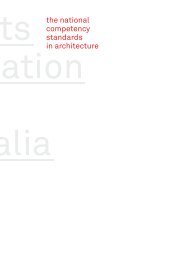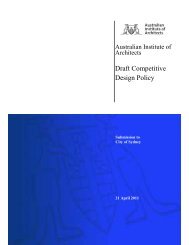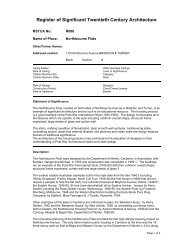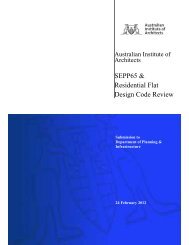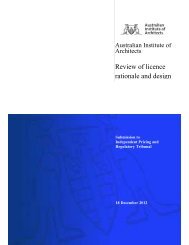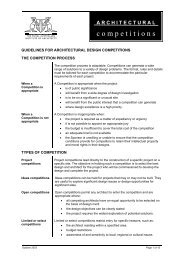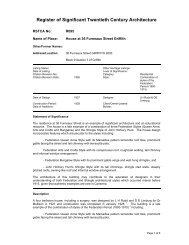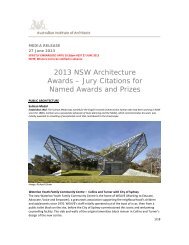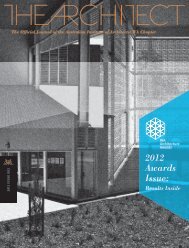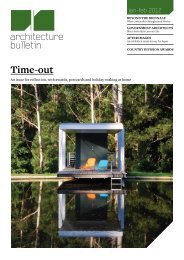Universal Access Policy - Australian Institute of Architects
Universal Access Policy - Australian Institute of Architects
Universal Access Policy - Australian Institute of Architects
You also want an ePaper? Increase the reach of your titles
YUMPU automatically turns print PDFs into web optimized ePapers that Google loves.
<strong>Universal</strong> <strong>Access</strong><strong>Policy</strong>SummaryThe <strong>Australian</strong> <strong>Institute</strong> <strong>of</strong> <strong>Architects</strong> (The <strong>Institute</strong>) believes thatensuring a high level <strong>of</strong> accessibility within the built environment forpeople <strong>of</strong> all abilities must be a matter <strong>of</strong> priority for governments andthe community as whole.Most <strong>Australian</strong>s will experience a form <strong>of</strong> disability at some stage <strong>of</strong>their lives as a part <strong>of</strong> the normal human life cycle. Physical andnon-physical barriers within the built environment can have asubstantial impact on freedom <strong>of</strong> movement and therefore freedom<strong>of</strong> choice. Policies designed to ensure universal access within thebuilt environment are essential, particularly in light <strong>of</strong> Australia’sageing population.Governments must continue to work toward ensuring universalaccess for all citizens. Legislated uniform standards for accessiblepublic and private housing are necessary and universal housingprovisions should be included in planning schemes. <strong>Architects</strong>should, in co-operation with the broader community, work toward theelimination <strong>of</strong> barriers to equitable access with the built environment.© 2008 The <strong>Australian</strong> <strong>Institute</strong> <strong>of</strong> <strong>Architects</strong>1
<strong>Universal</strong> <strong>Access</strong><strong>Policy</strong>BackgroundA period <strong>of</strong> disability, whether permanent or temporary, is a normalpart <strong>of</strong> the human life cycle for a majority <strong>of</strong> <strong>Australian</strong>s. There arephysical and non-physical barriers within the built environment whichcan limit freedom <strong>of</strong> movement and choice for a significant number <strong>of</strong>people, especially people with disabilities, people with limited mobilityand older people. <strong>Universal</strong> access, which accommodates the needs<strong>of</strong> all people regardless <strong>of</strong> age and ability, benefits the wholecommunity and is, therefore, a community responsibility. The<strong>Institute</strong> recognises that the architectural pr<strong>of</strong>ession has a significantrole in determining the level <strong>of</strong> accessibility in the built environment,including heritage buildings, public and private housing, and outdoorbuilt environments. We affirm the responsibility <strong>of</strong> the architecturalpr<strong>of</strong>ession to contribute to the provision <strong>of</strong> universal accessthroughout the built environment as a basic human right.Existing rights <strong>of</strong> access to public facilities and buildings aregoverned by the combined effect <strong>of</strong> the prohibition on discriminationcontained in the Disability Discrimination Act 1992 (DDA92) togetherwith the provisions <strong>of</strong> the applicable State or Territory EqualOpportunity legislation and the technical requirements contained inthe Building Code <strong>of</strong> Australia (BCA).In recognition that the BCA does not completely capture the intent <strong>of</strong>the DDA, a review <strong>of</strong> this regulatory framework has been underwaysince 2000, led by the <strong>Australian</strong> Building Codes Board. A DraftDisability Standards on <strong>Access</strong> to Premises was submitted in 2005 tothe Federal Attorney General and the Federal Minister for Industry,Tourism and Resources for their endorsement.© 2008 The <strong>Australian</strong> <strong>Institute</strong> <strong>of</strong> <strong>Architects</strong>2
<strong>Universal</strong> <strong>Access</strong><strong>Policy</strong>What Governments need to doThe need to ensure access for people <strong>of</strong> all abilities includingAustralia’s rapidly growing ageing population necessitates theadoption <strong>of</strong> legislated uniform standards for accessible public andprivate housing which take into account the occupants’ needs thatmay change across their life span. Currently, the demand forvisitable, adaptable or accessible housing far exceeds supply.The <strong>Institute</strong> supports the efforts already being made by Federal,State and Local Government bodies and the community to eliminatebarriers to accessibility in the built environment, in accordance withthe human rights declarations to which Australia is a signatory.The <strong>Institute</strong> supports the adoption <strong>of</strong> a Disability Standards on<strong>Access</strong> to Premises that incorporates the 90th percentile <strong>of</strong>wheelchair sizes and users in accordance with the intent <strong>of</strong> theDDA92.The <strong>Institute</strong> encourages the inclusion <strong>of</strong> housing accessibilityprovisions in planning schemes.© 2008 The <strong>Australian</strong> <strong>Institute</strong> <strong>of</strong> <strong>Architects</strong>3
<strong>Universal</strong> <strong>Access</strong><strong>Policy</strong>What <strong>Institute</strong> members need to doBe aware that the design and form <strong>of</strong> the built environment can be acause <strong>of</strong> disablement. Recognise that within the <strong>Australian</strong> society a spectrum <strong>of</strong>differing abilities exists and to raise awareness amongstmembers, clients and building pr<strong>of</strong>essionals <strong>of</strong> prejudices thathave resulted in barriers to universal access. Develop the skills necessary to meet their pr<strong>of</strong>essionalobligations in regard to accessible built environments throughappropriate education and pr<strong>of</strong>essional development training. Be aware that the <strong>Institute</strong> has an expanding list <strong>of</strong> specificadvisory notes on <strong>Universal</strong> <strong>Access</strong>, for example on the topic<strong>of</strong> the DDA, pr<strong>of</strong>essional <strong>of</strong>fices, heritage buildings, transportbuildings, design for hearing impairment, and signageformats. In co-operation with the broader community, purposefullywork towards the elimination <strong>of</strong> barriers to equitable accesswithin the built environment. Participate in <strong>Institute</strong> access-related activities, such as theNational <strong>Access</strong> Work Group and its <strong>Access</strong> Sub-Committees at State and Territory Chapter levels. Recognise the unique and sensitive nature <strong>of</strong> implementingaccessibility modifications while protecting the integrity andsignificance <strong>of</strong> heritage properties. Work in collaboration withthose with the skill and understanding <strong>of</strong> the issues requiredto evaluate and implement the appropriate access solutionwithin a conservation context.© 2008 The <strong>Australian</strong> <strong>Institute</strong> <strong>of</strong> <strong>Architects</strong>4
<strong>Universal</strong> <strong>Access</strong><strong>Policy</strong>Further Information and LinksUnited Nations Convention on the Rights <strong>of</strong> Persons with Disabilitieshttp://www.un.org/esa/socdev/enable/rights/convtexte.htm<strong>Australian</strong> Building Codes Board, <strong>Access</strong> for People with Disabilitieshttp://www.abcb.gov.au/index.cfm?fuseaction=PublicationsQueensland Office <strong>of</strong> the Public Advocate, Housing Design for Allhttp://jp.justice.qld.gov.au/guardian/pa/discussion/ip3_0305.pdfHuman Rights and Equal Opportunity Commission, Advisory Noteson <strong>Access</strong> to Premiseshttp://www.hreoc.gov.au/.../premises_advisory.htmlHuman Rights and Equal Opportunity Commission, <strong>Access</strong>ible andadaptable housinghttp://www.humanrights.gov.au/.../access_to_premises.htmlNew South Wales Premier’s Council for Active Living, DesigningPlaces for Active Livinghttp://www.pcal.nsw.gov.au/planning_design_guidelines/<strong>Institute</strong> Submissions on access to public premises and accessiblehousinghttp://www.architecture.com.au/i-cms?page=4104Building Commission <strong>of</strong> Victoria, Welcome – Design Ideas for<strong>Access</strong>ible HomesAvailable for purchase via:http://www.buildingcommission.com.au/...-access-to-housing.asp© 2008 The <strong>Australian</strong> <strong>Institute</strong> <strong>of</strong> <strong>Architects</strong>5
<strong>Universal</strong> <strong>Access</strong><strong>Policy</strong>ACT Planning and Land Authority, Interim Guidelines for <strong>Access</strong> andMobilityhttp://www.legislation.act.gov.au/.../current/pdf/2003-363.pdfImproving <strong>Access</strong> to Heritage Buildings by Eric Martin, available free<strong>of</strong> charge on the <strong>Australian</strong> Heritage Council websitehttp://www.ahc.gov.au/publications/generalpubs/access/index.htmlDeafness Forum <strong>of</strong> Australia, <strong>Policy</strong> statements on communicationaccess in a variety <strong>of</strong> facilitieshttp://www.deafnessforum.org.au/position%20statements.htm© 2008 The <strong>Australian</strong> <strong>Institute</strong> <strong>of</strong> <strong>Architects</strong>6




